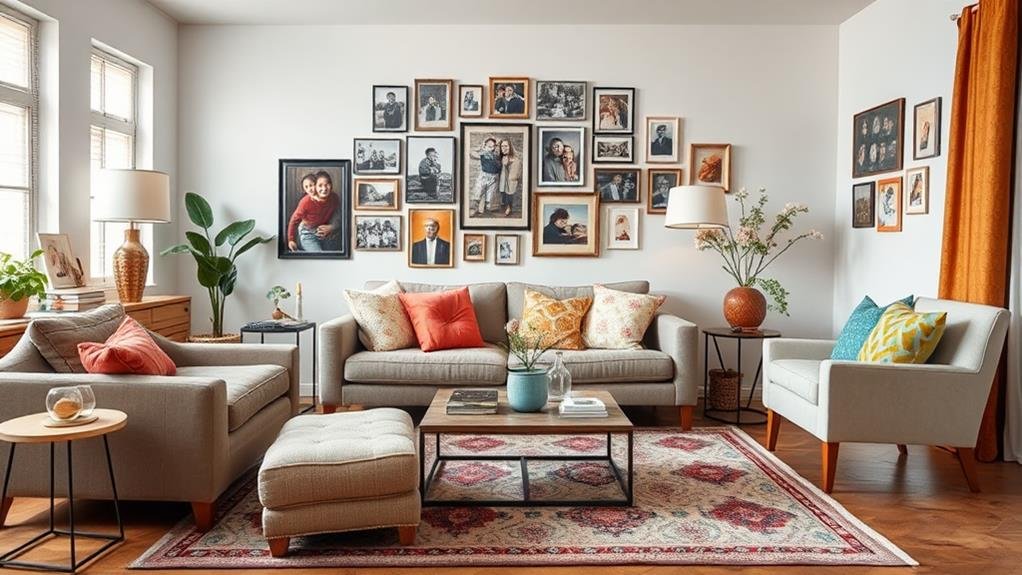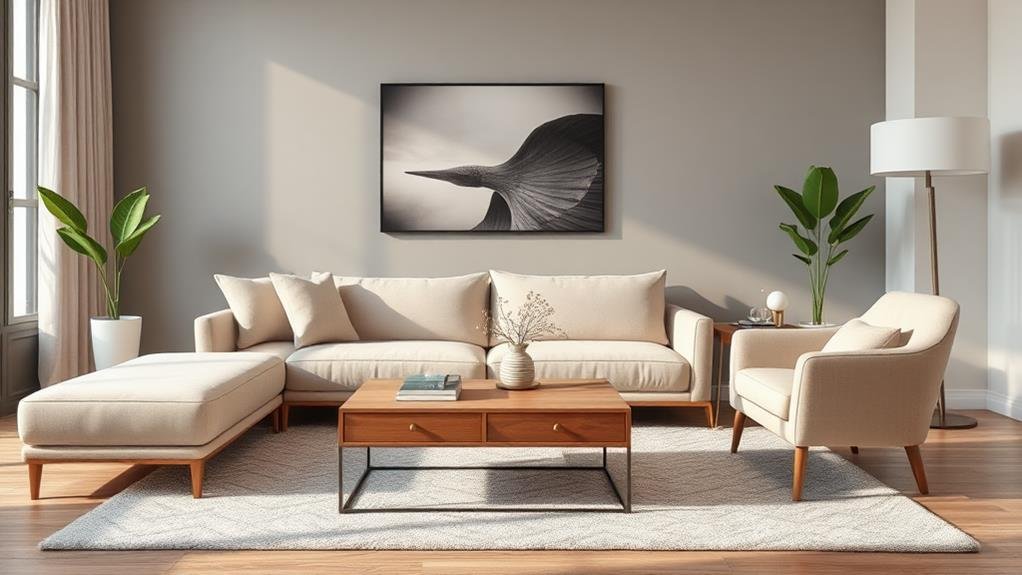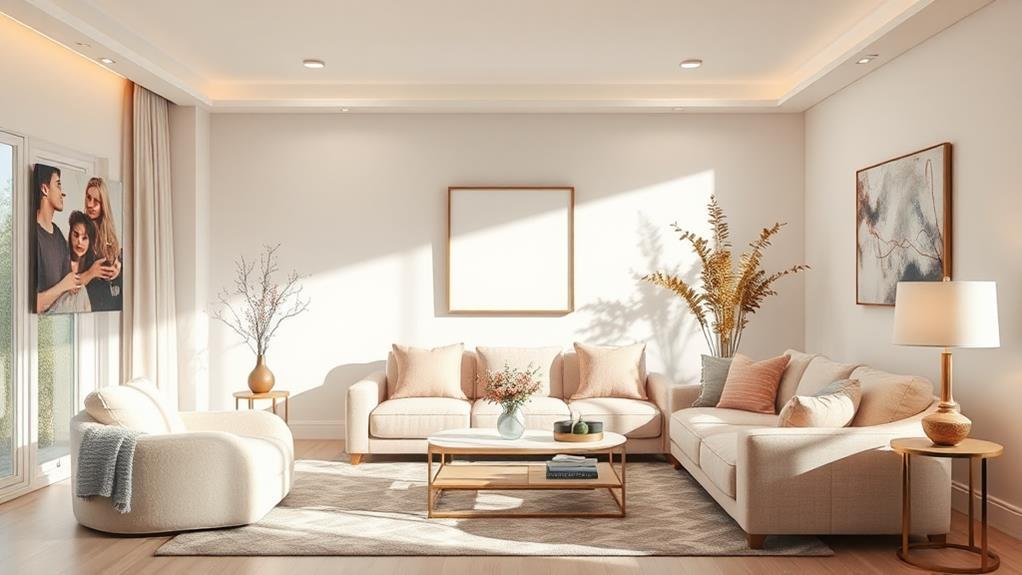Transform your home into a personal retreat by harnessing the power of interior design. Select colors strategically to evoke emotions and set the tone of each room; blend hues for harmony and depth. Optimize furniture layout to maximize space usage and functionality, creating multi-purpose areas and clear pathways. Enhance ambiance with mood lighting and textured decor while incorporating elements that reflect your unique style for a truly personalized touch. Balance form and function seamlessly to create cozy, efficient spaces that elevate your everyday living experience. Embrace the art of design to craft a sanctuary that nurtures and inspires.
Key Takeaways
- Strategic furniture arrangement optimizes space and functionality.
- Thoughtful color choices set the mood and enhance visual appeal.
- Personalized decor elements add character and uniqueness.
- Creating focal points directs attention and creates visual interest.
- Incorporating textures and patterns adds depth and visual appeal.
Impact of Color Choices

When it comes to interior design, the impact of color choices can't be overstated. Color psychology plays a vital role in eliciting emotional responses and setting the tone for a space. Different colors can evoke various feelings; for example, blues and greens often create a sense of calm, while yellows and oranges can bring warmth and energy.
Color trends are heavily influenced by cultural factors, with some societies favoring vibrant hues while others prefer more muted tones.
Achieving color harmony is essential when designing a room. Utilizing accent colors strategically can add depth and interest to a space, while monochromatic schemes create a sophisticated and cohesive look.
Introducing color contrasts, such as pairing a bold color with a neutral one, can make a room pop and draw the eye to specific elements.
Incorporating color choices thoughtfully can transform a room, making it feel inviting, energizing, or relaxing, depending on the desired effect. It's a powerful tool in interior design that allows for endless creativity and personal expression.
Furniture Layout Optimization

Arranging furniture strategically can make a world of difference in your living space.
By optimizing your layout, you can maximize space utilization, ensuring each corner serves a purpose.
Functional furniture arrangement not only enhances room flow but also elevates the overall aesthetic of your home.
Space Utilization Tips
Optimize your furniture layout to maximize the space in your home and create a more functional and visually appealing environment.
Start by incorporating zone planning to designate specific areas for different activities, allowing for multi-purpose spaces that serve various functions. Utilize vertical storage to make the most of your wall space and consider decluttering strategies to free up room and create an open concept feel.
Introduce room dividers to delineate spaces within an open floor plan, ensuring adaptable layouts that can be easily modified as needed.
Implement space zoning to establish efficient pathways and define separate areas within a room. Consider furniture scaling to ensure that pieces fit proportionally within the space without overwhelming it.
Functional Furniture Arrangement
To create a harmonious and efficient living space, consider the arrangement of your furniture as a crucial aspect of interior design. Proper space planning is key to ensuring that each piece serves a purpose while maintaining a visually appealing layout.
One way to achieve this is by optimizing furniture versatility. Look for pieces that can be used in multiple ways, such as a coffee table with hidden storage or a sofa that can also serve as a guest bed. This not only maximizes the functionality of each item but also helps in making the most out of limited space.
When arranging your furniture, take into account the flow of movement within the room. Ensure that there are clear pathways and that each piece is placed in a way that complements the overall design.
Room Flow Enhancement
Enhance the flow of your room by strategically rearranging your furniture layout. Achieving optimal room connectivity and spatial harmony is essential for creating a welcoming and functional space.
Start by considering the natural pathways in the room and ensure that furniture placement doesn't obstruct these routes. Allow for easy movement between different areas of the room by arranging furniture in a way that encourages a smooth flow.
Position larger furniture pieces against walls to open up the central space and create a sense of openness.
Consider the function of each area within the room and arrange furniture to support these activities. For example, group seating areas into cozy conversation spots or create a reading nook by placing a comfortable chair near a window.
Decor Arrangement Techniques

Transforming your living space through effective decor arrangement techniques can breathe new life into your home. To achieve a harmonious and visually appealing environment, consider the interplay of decor styles, spatial harmony, and thematic cohesion.
Start by incorporating arrangement principles that promote aesthetic balance and style continuity throughout the space. Pay attention to the visual weight of each element and ensure that accessory placement enhances the overall decor contrast.
Maintaining arrangement balance is key to preventing overcrowding or empty spaces. Create a sense of cohesion by strategically placing decor items that complement each other while adding layers of interest.
Experiment with different textures, heights, and colors to bring depth to your decor arrangement. Remember that simplicity can also make a powerful statement in achieving style continuity and spatial harmony.
Lighting Strategies for Ambiance

As you curate the ambiance of your living space, lighting plays a pivotal role in setting the mood and enhancing the overall aesthetic appeal.
When considering lighting strategies for ambiance, here are some key points to keep in mind:
- Light Layering: Utilize a combination of ambient lighting, task lighting, and accent lighting to create depth and visual interest in your space.
- Color Temperature: Choose light bulbs with warm tones for a cozy atmosphere or cooler tones for a more modern feel.
- Natural Illumination: Maximize natural light by incorporating window treatments that allow for optimal daylight while maintaining privacy.
- Decorative Fixtures: Add character to your space with unique and stylish light fixtures that serve as both functional lighting sources and decorative elements.
Personalized Style Integration

Personalized Style Integration allows you to infuse your unique personality and preferences into your home's design, creating a space that reflects your individuality and taste.
One way to achieve this is through personalized artwork that showcases your favorite colors, themes, or memories. These pieces not only add a personal touch but also serve as conversation starters for guests.
In addition to artwork, tailored accessories play a crucial role in integrating your style into your home. Whether it's accent pillows, rugs, or curtains, choosing accessories that resonate with your aesthetic can tie the room together while reflecting your personal flair.
Mixing and matching textures, patterns, and colors can create a cohesive yet personalized look that's uniquely yours.
Space Maximization Through Design

To maximize space through design, consider the strategic placement of furniture and the utilization of multifunctional pieces.
When designing your space with spatial efficiency in mind, here are some key strategies to keep in mind:
- Utilize vertical space: Explore tall bookshelves or floor-to-ceiling cabinets to make the most of your room's height.
- Incorporate hidden storage: Opt for furniture pieces with secret compartments or under-bed storage to keep clutter at bay.
- Create multifunctional areas: Designate zones that serve dual purposes, like a workspace that can transform into a dining area.
- Implement open shelving: Open shelves can provide storage while maintaining a sense of visual continuity and openness in the room.
Creating Focal Points

Enhancing your interior design with focal points is crucial in creating visual interest and drawing attention to specific areas within your space. Focal points act as anchors that guide the eye and establish a visual hierarchy in a room.
When choosing focal point materials, consider items like a statement piece of art, a vibrant accent wall, or a striking piece of furniture. These elements not only add personality and charm to your space but also serve as conversation starters.
To effectively create focal points, ensure they stand out without overwhelming the rest of the room's design. Strategic placement and complimentary colors can help achieve this balance.
For instance, a bold rug in a neutral room can serve as a focal point, drawing the eye and adding warmth to the space.
Incorporating Texture and Patterns

Create visual depth and intrigue in your home by skillfully incorporating texture and patterns into your interior design.
When it comes to creating a space that truly captivates, consider the following:
- Textural Contrasts: Play with different textures like velvety cushions against smooth leather sofas to add interest and dimension.
- Pattern Layering: Experiment with layering patterns through rugs, curtains, and throw pillows for a dynamic look.
- Tactile Elements: Incorporate elements that not only look good but feel good—think soft throws, plush carpets, or rough stone accent walls.
- Visual Rhythm: Establish a rhythm by repeating certain textures or patterns throughout the space, creating a cohesive and visually pleasing flow.
Balancing Form and Function

Achieving a harmonious blend of aesthetics and practicality is key when it comes to interior design. Balancing form and function involves creating an aesthetic balance while ensuring functional harmony within a space.
Design principles guide the way, considering usability factors and practical considerations alongside visual appeal. Style coherence plays a vital role in tying everything together seamlessly.
To achieve this balance, consider how different elements enhance comfort and spatial efficiency. Each piece shouldn't only look good but also serve a purpose, enhancing the overall functionality of the space.
By integrating artistic elements strategically, you can elevate the visual appeal while maintaining usability.
Finding the sweet spot where form meets function can transform a room into a cozy yet efficient space. Whether it's choosing furniture that provides both style and comfort or optimizing layout for maximal efficiency, the art of balancing form and function can truly elevate your home's interior design.
Flow and Connectivity in Spaces

Creating a sense of flow and connectivity within a space is essential for a cohesive and inviting interior design. Achieving spatial harmony and seamless transitions in your home will elevate the overall aesthetic and functionality of each room.
- Spatial Harmony: By ensuring that each element in a room complements the others, you create a harmonious environment that feels balanced and visually appealing.
- Open Sightlines: Consider how each area of your space connects visually with the next, allowing for a seamless flow from one room to another.
- Functional Zones: Define different areas within a room to serve specific purposes while still maintaining a unified design scheme throughout.
- Consistent Color Palette: Using a cohesive color scheme throughout your space can tie everything together, promoting a sense of continuity and flow.
Mood Elevation With Design Elements

To uplift the ambiance of your living space, infusing a sense of positivity and vibrancy through carefully selected design elements can make a significant impact. By incorporating principles of design psychology and color psychology, you can create emotional spaces that elevate your mood and well-being. Utilizing sensory experiences such as mood lighting and texture influence, you can enhance your environment to foster a personal sanctuary that reflects your inner self.
—
| Design Elements | Effect |
|---|---|
| Color Psychology | Aesthetic Impact |
| Spatial Harmony | Emotional Spaces |
| Mood Lighting | Mood Elevation |
| Texture Influence | Environment Enhancement |
Adding Personality Through Details

Enhance the character of your space with customized decor accents that reflect your style and interests, such as unique statement pieces that spark conversation and intrigue.
Infuse a touch of your personality into your home by selecting personalized color schemes that evoke emotions and memories, creating a space that's uniquely yours.
Customized Decor Accents
A personalized touch can truly elevate the ambiance of your living space. Customized decor accents are a fantastic way to infuse your personality into your home while adding a unique flair. Here are some ideas to inspire you:
- Artistic Wall Decor: Invest in abstract paintings, gallery walls, or handmade crafts that speak to your style and interests. They can serve as statement pieces and conversation starters.
- Customized Textiles: Consider personalized throw pillows, embroidered curtains, or monogrammed blankets to create a cozy and inviting atmosphere that reflects your taste.
- Unique Photo Displays: Showcase your memories with custom photo frames, creative photo collages, or bespoke photo books that add a personal touch to your space.
- Handcrafted Ornaments: Incorporate handcrafted pottery, artisanal ceramics, or DIY projects to bring a touch of individuality and craftsmanship to your decor scheme.
Unique Statement Pieces
Adding unique statement pieces to your home décor can effortlessly infuse individuality and charm into your living space.
Choose artistic sculptures to create a focal point or opt for vintage finds to add a touch of nostalgia. Bold murals can make a dramatic impact, while eclectic textiles bring warmth and personality.
Statement lighting fixtures not only illuminate your space but also serve as eye-catching accents. Incorporate unique furniture pieces that reflect your style and taste. Handcrafted art pieces add a personalized touch, and innovative wall decor can spark conversation.
Consider custom installations for a one-of-a-kind look and don't shy away from unexpected accessories that show off your creativity.
Each of these elements contributes to a space that feels uniquely yours, creating a home that tells your story in a visually captivating way.
Personalized Color Schemes
As you strive to infuse your living space with individuality and charm through unique statement pieces, the selection of personalized color schemes becomes a key component in adding personality through details.
Personalized color schemes aren't just about paint; they delve into the realms of color psychology and emotional resonance, creating a harmonious blend that speaks to your soul.
Here are some key factors to consider when incorporating personalized color schemes into your home:
- Reflect Your Style: Choose colors that reflect your personality and style, creating a space that feels uniquely "you."
- Consider Room Function: Utilize color psychology to select hues that enhance the intended function of each room, fostering the desired atmosphere.
- Create Cohesion: Harmonize the color palette throughout your home to create a cohesive flow, connecting each space seamlessly.
- Play with Accents: Use contrasting colors or bold accents strategically to add pops of interest and personality to your design scheme.
With personalized color schemes, your home becomes not just a living space but a reflection of your innermost self, evoking emotions and warmth in every corner.
Conclusion
In conclusion, by implementing interior design principles, you can truly transform your home into a reflection of your personal style and create a space that not only looks great but also functions efficiently. Remember, the devil is in the details, so don't overlook the small touches that can make a big impact. With the right techniques and a little creativity, your home can become a beautiful sanctuary that you never want to leave.

